Content
The 'Big bang' of microelectronics
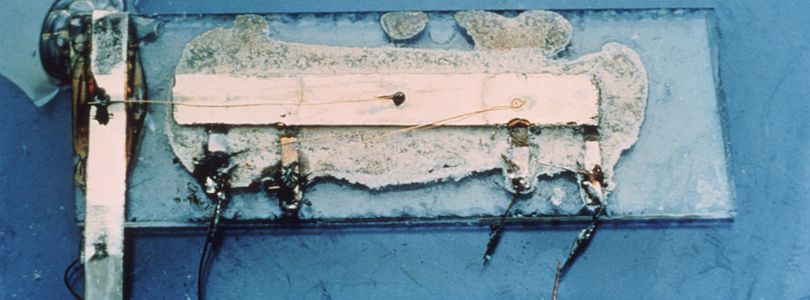
The very first Integrated Circuit by Jack Kilby
The very first IC
65 years ago: Patent for Jack Kilby
65 years ago, on February 6, 1959, Jack Kilby applied for a patent for "Minituarised electronic circuits" (US3138743A). It made him "father of the microchip". Jack St. Clair Kilby, who would have had celebrated his 100th birthday recently, was born in Jefferson City, Missouri, on 8 November 1923. He spent most of his youth in Great Bend, Kansas. He went to Illinois to study electrical engineering and later to the University of Wisconsin in Milwaukee. In 1958, he began working for Texas Instruments, to which he remained attached throughout his life and where he made most of his numerous inventions. In 1970, he took a leave of absence to work as a freelance inventor. From 1978 to 1984, he was a professor of electrical engineering at Texas A&M University. In 2000, he received the Nobel Prize in Physics. Jack Kilby died on 20 June 2005 in Dallas.
Here is the story of an engineer who was not allowed to take a vacation - and who made a groundbreaking invention during this time.
Jack Kilby had just started his new job at Texas Instruments in Dallas in the summer of 1958 and was therefore banned from taking holidays. While his colleagues were all away on vacation, the lonely Kilby made good use of the time in the empty laboratory. When his team returned from the holidays, Kilby presented them with a milestone in the history of technology on September 12, 1958: the first integrated circuit, practically the progenitor of the microchip.
A decisive breakthrough towards microelectronics had taken place a few years earlier with the invention of the transistor: In 1947, John Bardeen, William Shockley and Walter Houser Brattain developed the bipolar transistor at Bell Laboratories - still the cornerstone of all microelectronics today. Together, they received the Nobel Prize for this in 1956.
Important steps in this direction had already been taken earlier (Julius Edgar Lilienfeld recieved the first for the transistor principle in 1925), but they were not ready for practical use.
Breakthrough with semiconductors
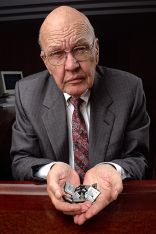
Jack Kilby
The transistor could now replace the large, heavy electronic valves, but since a lot of transistors were needed for more complex computational tasks and these had to be wired in a complex way, the problem was still that a lot of space and material was needed for the calculating machines.
This problem was solved by Jack St. Clair Kilby from Great Bend, Kansas (1923-2005). He combined transistor, resistor and capacitor on a common component. The decisive factor with the Integrated Circuit (IC) is the fact that the components are mounted on a plate, which is itself a component of the circuit. The semiconductor material (Kilby used germanium, today silicon is most common) saves cabling and makes it possible to accommodate a large number of transistors in a very small space.
Kilby's circuit was a so-called "flip-flop" or "bistable multivibrator". Such one-bit memories are still the basic element of any computer memory today.
Kilby's invention did not come out of the blue: Werner Jacobi, who worked for Siemens & Halske in Erlangen, had already filed his "semiconductor amplifier" with the DPMA in 1949 ( ![]() DE833366B), which anticipated essential elements of an integrated circuit. The British electrical engineer Geoffrey Dummer is also said to have designed an integrated circuit around 1950 (but without having applied for IP rights).
DE833366B), which anticipated essential elements of an integrated circuit. The British electrical engineer Geoffrey Dummer is also said to have designed an integrated circuit around 1950 (but without having applied for IP rights).
The first one to register takes the prize
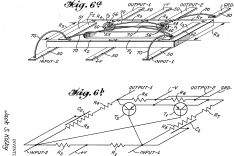
"Miniaturized electronic circuits": drawing from Kilby´s US 3138743
The story of Kilby and the IC is also a lesson that shows once again how important it is to quickly register and protect your intellectual property. At the same time and independently of Kilby, Robert Noyce had also developed the integrated circuit( ![]() US 2981877A). Noyce worked for Fairchild Semiconductors, who had just developed the first diffusion bipolar transistor. Noyce was even one step ahead of Kilby and was already using photolithographic processes and diffusion processes to produce his IC. But Kilby was the first to apply for a patent for his development (
US 2981877A). Noyce worked for Fairchild Semiconductors, who had just developed the first diffusion bipolar transistor. Noyce was even one step ahead of Kilby and was already using photolithographic processes and diffusion processes to produce his IC. But Kilby was the first to apply for a patent for his development ( ![]() US 3138743 A).
US 3138743 A).
There were years of patent disputes, but in retrospect Kilby and Noyce went down in history as equal inventors of the IC. When Kilby received the Nobel Prize in Physics in 2000, he was certain that he would have been awarded the prize together with Noyce had he been alive: "While Robert and I followed our own paths, we worked hard together to achieve commercial acceptance for integrated circuits. If he were still living, I have no doubt we would have shared this prize." Noyce, co-founder of Intel and early investor of AMD, had already died in 1990.
Rapid development deep into the nano range
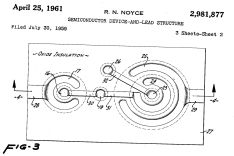
"Semiconductur device-and-lead structure": drawing from Robert Noyce´s US 2981877 A
But when Kilby and Noyce developed the IC in the late 1950s, virtually nothing happened at first. It took some time for the IC and the first microprocessors to establish themselves on the market. A milestone was the first pocket calculator presented by Texas Instruments in 1966, in whose development Kilby played a major role. Kilby is also regarded as the father of the thermal printer.
The integrated circuit is still the basic element of digital technology today, whether in kitchen appliances, smartphones, cars and, of course, computers. As Moore's Law predicted in 1965, the number of circuits that can be accommodated on a chip doubles every 18 months or so. Today, the microprocessor of a PC can contain several billion transistors.
But how can such an unimaginable number of circuits be accommodated on a small silicone plate? Semiconductor wafers prepared with photoresist are usually exposed in various steps using a photolithographic process. The complex structures of the microchip are applied. Today, these structures can be resolved into the single-digit nanometer range.
Dozens of patents
In the course of his long career as an inventor, Jack Kilby filed dozens of patents, many of them in Germany.
Several of them improved the application possibilities of integrated circuits, such as „Anordnung und Verfahren zum schaltungsmäßigen Verbinden einer Anzahl von übereinandergestapelten Schaltplatten in Modulbauweise“ (Arrangement and method for connecting a number of circuit boards stacked on top of each other in a modular construction)( ![]() DE1132202) or "„Integrierte Halbleiterschaltungsanordnung“ (Integrated semiconductor circuit arrangement)(
DE1132202) or "„Integrierte Halbleiterschaltungsanordnung“ (Integrated semiconductor circuit arrangement)( ![]() DE1207511A,1960).
DE1207511A,1960).
From today's perspective, his voluminous answering machine from 1958 seems curious: "Telephone answering device" (US2823262A). Technically, however, it was well ahead of most of the devices available at the time.
Teaching machine and pocket calculator
Kilby also developed a kind of learning computer: "Teaching machine" ( ![]() US3386187A, 1966).. It was a kind of multiple-choice question machine: "This invention relates (...) to a machine for teaching arithmetic or other subjects which can be taught by repetitive drill. (...) The problems are prepared on a film strip and presented to the student, one at a time. The student responds by selecting one of a number of keys representative of the possible answer. If the key corresponding to the correct answer is selected, the film strip is automatically indexed to the next frame. If the incorrect answer is selected, the Student may either select another key, or may depress an answer button which causes the correct answer to be revealed. Then by depressing the correct key, the film strip will index to the next problem."
US3386187A, 1966).. It was a kind of multiple-choice question machine: "This invention relates (...) to a machine for teaching arithmetic or other subjects which can be taught by repetitive drill. (...) The problems are prepared on a film strip and presented to the student, one at a time. The student responds by selecting one of a number of keys representative of the possible answer. If the key corresponding to the correct answer is selected, the film strip is automatically indexed to the next frame. If the incorrect answer is selected, the Student may either select another key, or may depress an answer button which causes the correct answer to be revealed. Then by depressing the correct key, the film strip will index to the next problem."
One of his most important inventions was the thermal printer, which is still widely used today ( ![]() US3496333A,1965). And of course the pocket calculator, with which the triumph of the integrated circuit really began. One of the underlying patents is "Elektronischer Kleinstrechner" (
US3496333A,1965). And of course the pocket calculator, with which the triumph of the integrated circuit really began. One of the underlying patents is "Elektronischer Kleinstrechner" ( ![]() DE1774893A (4,57 MB)), , applied for in 1968.
DE1774893A (4,57 MB)), , applied for in 1968.
But Kilby also proved to be a true technical visionary through his early involvement with solar energy: "The need to replace fossil fuels as a source of energy is well known," he wrote as early as 1976 in his patent application "Energiewandler" (Energy Converter) ( ![]() DE2633878A1 (1,7 MB)): "The invention relates to the effective conversion and storage of energy from light sources such as the sun. Light falling on junction photocells produces a voltage which causes a current to flow through an electrolyte in contact with the sources, causing a chemical reaction in the electrolyte."
DE2633878A1 (1,7 MB)): "The invention relates to the effective conversion and storage of energy from light sources such as the sun. Light falling on junction photocells produces a voltage which causes a current to flow through an electrolyte in contact with the sources, causing a chemical reaction in the electrolyte."
Kilby continued to work on improving the application possibilities for integrated circuits into old age. He filed his last patent application in 1995 ( ![]() US5611884A).
US5611884A).
Text: Dr. Jan Björn Potthast, Pictures: Texas Instruments, DEPATIsnet
Last updated: 10 December 2025

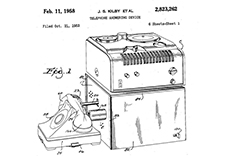
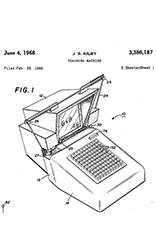
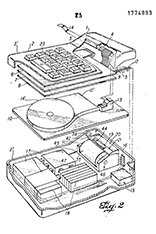
Not only protecting innovations
Social Media